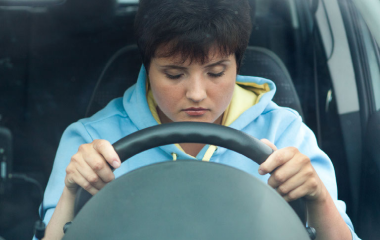People with sleep apnea are more likely to fail a driving simulator test and report nodding while driving, according to new research.
The study was presented on April 12, at the Sleep and Breathing Conference in Berlin, organized by the European Respiratory Society and the European Sleep Research Society.
Sleep apnea has previously been linked with an increased chance of being involved in road traffic accidents. A research team from the University Hospital in Leeds, UK, carried out two separate studies looking at the effect sleep apnea has on driving during a simulator test, carried out at the University of Leeds.
In the first study, 133 patients with untreated sleep apnea and 89 people without the condition took part in the test. All participants completed a 90 km motorway driving simulation and were tested on a number of key criteria, including: The ability to complete the distance, time spent in the middle lane, an unprovoked crash or a veer event crash.
The results showed that patients with untreated sleep apnea were more likely to fail the test. Twenty-four percent of the sleep apnea patients failed the test, compared to 12 percent of the people without the condition. Many patients with sleep apnea were unable to complete the test, had more unprovoked crashes and could not adhere to the clear driving instructions given at the beginning of the simulator test.
In the second study, 118 patients with untreated sleep apnea and 69 people without the condition completed a questionnaire about their driving behavior and undertook the 90 km driving test on the simulator.
Thirty-five percent of patients with sleep apnea admitted to nodding at the wheel and subsequently 38 percent of this group failed the test. This compared to 11 percent of people without the condition admitting to nodding and none of this group failing the test.
“In the first study, although some people in the control group also failed the test, there were several key differences in the reasons for failure,” said Dr. Mark Elliott, chief investigator. “For example 13 patients were unable to complete the test because they fell asleep, veered completely off the motorway and 5 patients because they spent more than 5 percent of the study outside of the lane that they had been instructed to remain in. No controls failed for either of these reasons. Further investigation is needed to examine the reasons for failure of the simulator test.”
The public health implications of drowsy driving are clear: The AAA Foundation for Traffic Safety estimates that more than 16 percent of fatal crashes involve a drowsy driver.
To promote awareness of drowsy driving, the AASM released a free online presentation describing the signs, causes and effects of driver fatigue and some strategies to manage it. SAFE-D: Sleep, Alertness and Fatigue Education for Drivers is available at aasm.org. The presentation also is on YouTube and Vimeo to share or embed.





